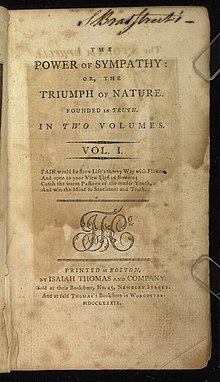William Hill Brown
This article needs additional citations for verification. (January 2013) |

William Hill Brown (November 1765 – September 2, 1793) was an American novelist, the author of what is usually considered the first American novel, The Power of Sympathy (1789) and "Harriot, Or The Domestick Reconciliation"[1] as well as the serial essay "The Reformer" published in Isaiah Thomas' Massachusetts Magazine. In both, Brown proves an extensive knowledge of European literature for example of Clarissa by Samuel Richardson but tries to lift the American literature from the British corpus by the choice of an American setting.
Biography
The son of a well-known clockmaker, Gawen Brown, and his third wife, Elizabeth Hill Adams Brown, William Hill Brown was born in Boston late in the year 1765. One of his older half brothers, Mather Brown, the son of Gawen Brown and his second wife (a daughter of the Reverend Mather Byles), became a well-known artist. William Hill Brown, who was always in frail health, was encouraged in his literary ambitions by Catherine Byles, one of Mather Brown's mother's unmarried half sisters.
Brown wrote the romantic tale "Harriot, or the Domestic Reconciliation" (1789), which was published in the first issue of Massachusetts Magazine, and the play West Point Preserved (1797), a tragedy about the death of a Revolutionary British spy, Major John André. He also wrote a series of verse fables, a comedy in West Indies style (Penelope), essays, and a short second novel about incest and seduction, Ira and Isabella (published posthumously, 1807). Brown went south to study law and died shortly thereafter in Murfreesboro, North Carolina on September 2, 1793.
References
- ^ Originally published in January 1789 in The Massachusetts Magazine. Carla Mulford (ed.) (2002): Early American Writing. Oxford University Press. New York. p. 1084ff.
